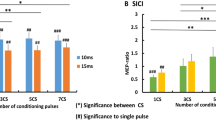Abstract
The effects of repetitive transcranial stimulation (rTMS) on brain activity remain unknown. In healthy subjects, we studied the effects of rTMS on the duration of the cortical silent period (SP). Repetitive stimuli were delivered with a Cadwell High Speed Magnetic Stimulator and a figure-of-eight coil placed over the hand motor area. rTMS was delivered in trains of 11 or 20 stimuli at frequencies of 3 and 5 Hz and at stimulation intensities of 110 and 120% of motor threshold. The SP was recorded from the forearm muscles during a voluntary contraction (20% of maximum effort). rTMS delivered at a frequency of 3 and 5 Hz and intensities of 110 and 120% motor threshold prolonged the duration of the SP, without modifying either the size or the latency of the muscle-evoked potentials (MEP). A conditioning train of 11 stimuli at 3 Hz had no effect on the duration of the SP evoked by a single magnetic shock delivered 600 ms after the train. These findings show that rTMS increases the duration of the cortical SP, but does so only during the train of stimuli. rTMS probably changes the duration of the SP by facilitating cortical inhibitory interneurons.
Similar content being viewed by others
Author information
Authors and Affiliations
Additional information
Received: 4 December 1997 / Accepted: 11 August 1998
Rights and permissions
About this article
Cite this article
Berardelli, A., Inghilleri, M., Gilio, F. et al. Effects of repetitive cortical stimulation on the silent period evoked by magnetic stimulation. Exp Brain Res 125, 82–86 (1999). https://doi.org/10.1007/s002210050661
Issue Date:
DOI: https://doi.org/10.1007/s002210050661




